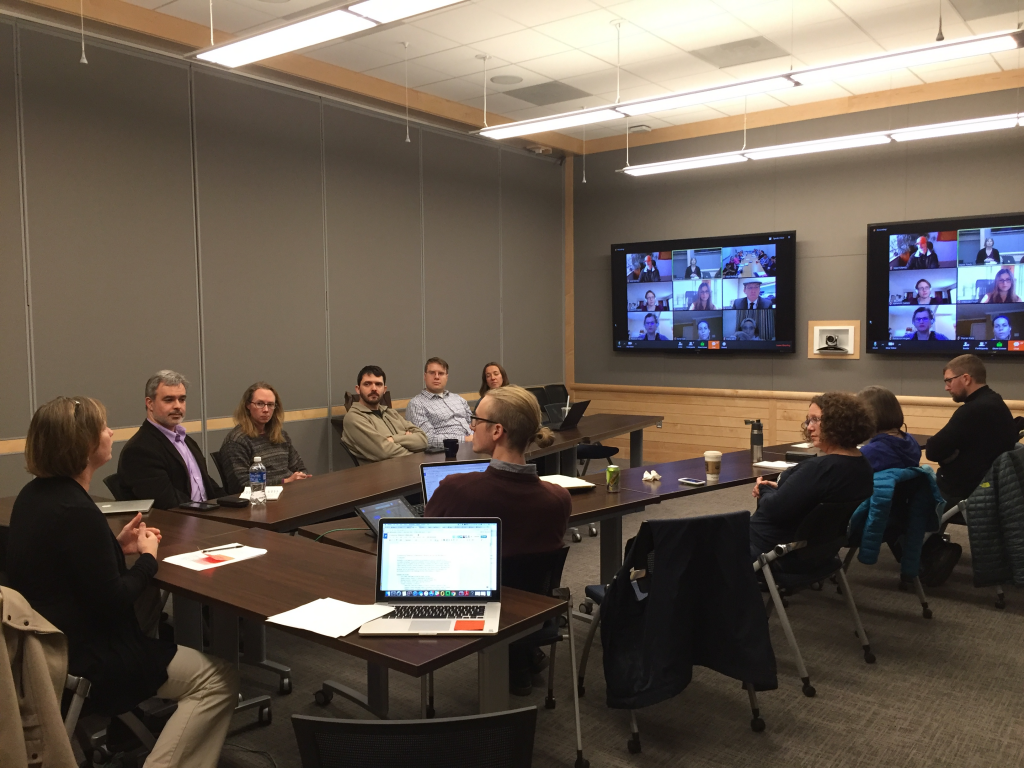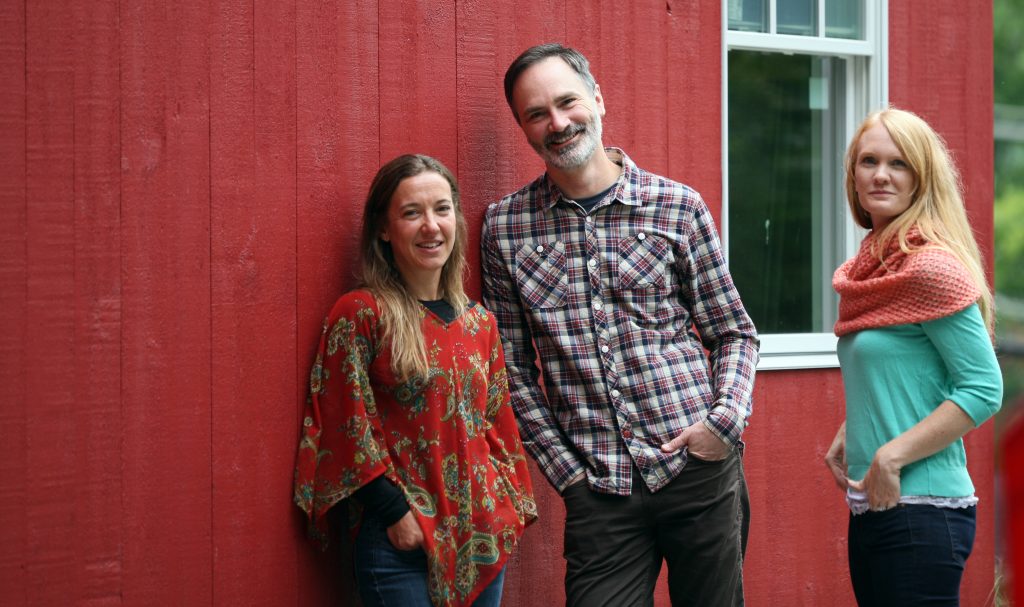Digital embodiment: Constructing and deconstructing the body [Part 3]
Now, I promised you two stories. The second, I very uncreatively called “digital embodiment.” What I mean is the intentional work of addressing, reflecting on, and reconfiguring digital bodies. This is the part of the talk that may be most applicable to you. Your work will be hybrid at least. The awareness can also help us in our work, as we connect across geographic distance, across cultures, digitally. I’m reminded of what our instructional designer Sean Morris once told me. He was working remotely for a company where, let’s say, they weren’t intentional about his digital embodiment. So in meetings, they would project him onto a screen then cover his face with whatever they needed to project–spreadsheets, websites, meeting notes, whatever. And they muted his audio. So basically, he was an observer. It impacted his morale, it impacted his connection to the team, it impacted his ability to work.
If you’ve ever tried to work with someone across distance using digital tools, you know that this can be challenging. But it can also be approached creatively, if you are willing to take digital embodiment seriously. We have been talking a lot about this at Middlebury, increasingly as part of the Envisioning Middlebury strategic planning process. Middlebury is a geographically-distributed institution. We have campuses or locations in Middlebury (VT), Ripton (VT), Monterey (CA), Santa Fe (NM), Oakland (CA), and 37 Schools Abroad locations. WOW.
We now have great technologies for connecting across distance. But we also need to take seriously questions of embodiment. I remember when I first interviewed for my job at Middlebury. I was gave a talk and some folks from the Monterey campus were invited to watch via videoconference. Maybe some of you. The room was set up so that the camera faced me, but the feed of people’s faces in Monterey was behind me. When they asked me questions, I wanted to look at their faces, but that would mean turning my back to the camera and, effectively, to them. We’ve come a long way since then, through intentional work. By paying attention to how we treat bodies.
This picture is from a meeting where approximately half of the attendees were joining virtually. And we spent a lot of time planning the room and the interactions to make this work. We spent hours choreographing the meeting ahead of time. It takes intentional work.
I have two fantastic instructional designers on my team. One works down the hall from me. The other, Sean, works waaaaaaaaaaay down the hall, in Portland, Oregon. I have been learning a lot about embodiment from working with someone on the other side of the country. And, through this work, my team has begun to frame important considerations for attending to embodiment via our digital connections. Here are a couple of things we have learned:
(1) The importance of presence. When we think about embodiment in our work across distance, presence comes up as an important concept. We privilege physical co-presence—and I think rightly so. The connection people can have when their physical bodies are together is strong and important. But sometimes we don’t have the opportunity to be together physically. So how can digital tools be used to help us to have embodied presence with each other?
You pay attention to presence. With Sean, my remote team member, we have established patterns of behavior that help with presence.
We took this picture when Sean was in town for a team retreat last year. I had prints of this picture (and several others) made and mailed to Sean. Now, his desk in Portland is adorned with pictures of him with his team. It’s a way to keep us present in his work environment.
Funny story related to presence: Every morning, Sean checks in with me on Slack, which is a communication tool my team uses to stay connected. He checks in about 7:30 AM his time–10:30 AM my time–which is about the time my early cup of coffee has worn off and I’m ready for some tea. Unknowingly, I started associating Sean’s check-ins with my tea time. To the point where I created a Pavlovian response to Sean’s check-ins. He checks in and I suddenly want tea. Or…I feel like drinking a cup of tea and I start wondering when Sean is going to check in. It’s silly, but we have used this as a way to create presence. Now, when Sean checks in in the morning, he often says…
I’ve seen similar strategies in fully-online programs or courses. Students may never meet face-to-face but, in order to develop presence, to better understand each other’s embodiments, students are asked to share pictures of where they learn. Where is your desk, where do you study? Bob Cole told me that one online program sends mugs to all of its students and, when the students meet via web conferencing, they all drink from their mugs. There are ways to recognize bodies, to embrace embodiment, even at a distance.
Another important part of digital embodiment involves addressing the lack of serendipity that can happen when you work only digitally with people. Sean once told me: “My meetings are always planned. I don’t get to just run into people in the halls.” He’s right. When you are physically co-present, serendipity happens. You run into someone at the coffee shop; you see someone in another building. But serendipity is difficult when working across distance. So as a team, we have been thinking about ways to bring more serendipity into our work.
One model that we’ve looked at for serendipity is Virtually Connecting. Virtually Connecting began when a couple of colleagues were frustrated by the options available to virtual conference attendees. If you have ever attended a conference, you know how important the networking and non-workshop times are. Yet virtual conference attendance focuses only on what happens inside sessions. These colleagues, Maha Bali and Rebecca Hogue, began experimenting with how to use technology to let virtual attendees participate in hallways conversations, in unscripted, unpredictable…maybe serendipitous conversations (I was at the first ET4Online conference where Maha and Rebecca tried this. Rebecca carried Maha around on her phone. It was charming). Virtually Connecting was born from this experimentation. Though the Virtually Connecting sessions are a bit more crafted now–they invite conference presenters to join Google Hangouts at specific times–the idea of creating informal hallway-like conversations remains the same. I also love that VConnecting forces people who are physically present at conferences to recognize that there are important voices who are not “in the room,” so to speak, at conferences and that it’s valuable to give space to people who haven’t had the privilege to attend the conference in-person.
My final message to you is that awareness really is key. Being aware of embodiment, whether physical or digital, can help us to connect better with each other. Open and honest dialogue is also key.
When I look at digital spaces I am going to use, for teaching, for connecting, for working, I ask how are we embodied in these digital spaces? Do we have agency over how we are embodied? Who decides and who has the power based on the embodiment?
Think of yourself as an ally to others when you ask those questions. Think of your embodiment, yes, but also think of yourself as an ally to others’ digital embodiment. Raise your voices against digital redlining, take seriously your role in critically evaluating and addressing embodiment. Be aware, be intentional, be an ally.
Additional note: I just learned that the new Digital Sociologies book edited by Jessie Daniels, Karen Gregory, and Tressie McMillan Cottom (three of my favorite people!) features some work on digital embodiment. I expect to be updating my blog with new posts about embodiment soon (My copy has not yet shipped because it’s sold out! HOORAY for them!)


